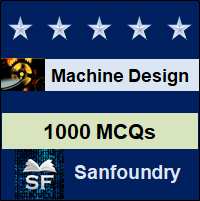This set of Machine Design Interview Questions & Answers focuses on “Effeciency of Screws”.
1. Efficiency of screw depends upon lead of the screw.
a) True
b) False
View Answer
Explanation: Efficiency= WL/[Pπd].
2. Efficiency of the screw depends upon helix angle but does not depend on friction angle.
a) True
b) False
View Answer
Explanation: Efficiency=tan(ἀ)/tan(Ǿ+ἀ) where ἀ=Helix angle and Ǿ=Friction angle.
3. Efficiency of the screw _______ with increase of coefficient of friction.
a) decreases
b) increases
c) has no effect
d) cannot be determined
View Answer
Explanation: Efficiency is inversely proportional to tan of the sum of helix and efficiency angle.
4. Maximum efficiency of a square threaded is given by
a) 1-sinǾ/1+sinǾ
b) 1+sinǾ/1-sinǾ
c) 1-2sinǾ/1+2sinǾ
d) 1+2sinǾ/1-2sinǾ
View Answer
Explanation: Efficiency=Sin(2ἀ+Ǿ)-Sin Ǿ/Sin(2 ἀ+Ǿ+Sin Ǿ),For max efficiency, sin(2ἀ+ Ǿ)=1.
5. If friction angle is 30’ then the maximum efficiency of the screw is
a) 33%
b) 66%
c) 50%
d) Noe of the mentioned
View Answer
Explanation: Maximum efficiency=1-sinǾ/1+sinǾ.
6. Maximum possible efficiency of a self-locking screw is
a) 50%
b) 75%
c) 66%
d) 33%
View Answer
Explanation: For self locking screw Ǿ(friction angle)>ἀ (helix angle), hence efficiency < tanǾ/tan(Ǿ+ἀ) or efficiency < tanǾ(1-tan²Ǿ)/2tanǾ.
7. In trapezoidal threads, f (coefficient of friction) can be taken as
a) f sec θ
b) f cos θ
c) f sin θ
d) f cosec θ
View Answer
Explanation: The normal force acting on the thread is W sec θ therefore the effect of the thread angle is to increase the frictional force by a term sec θ.
8. Clutch and coupling can be considered to be same.
a) True
b) False
View Answer
Explanation: Clutch is a temporary join while coupling is a permanent joint.
9. Cold rolled components have higher strengths and hardness than hot rolled components.
a) True
b) False
View Answer
Explanation: During grain re-structuring, original strength of material is lost.
10. Which of the following are true?
a) Cold working reduces toughness and ductility
b) Cold worked components have poor resistance to shocks and vibrations
c) Tooling for cold working is cheaper as compared to hot working
d) All of the mentioned
View Answer
Explanation: Properties of cold working.
Sanfoundry Global Education & Learning Series – Machine Design.
To practice all areas of Machine Design for interviews, here is complete set of 1000+ Multiple Choice Questions and Answers.
If you find a mistake in question / option / answer, kindly take a screenshot and email to [email protected]
- Check Mechanical Engineering Books
- Practice Mechanical Engineering MCQs
- Check Metallurgical Engineering Books
- Practice Metallurgical Engineering MCQs
- Check Machine Design Books

